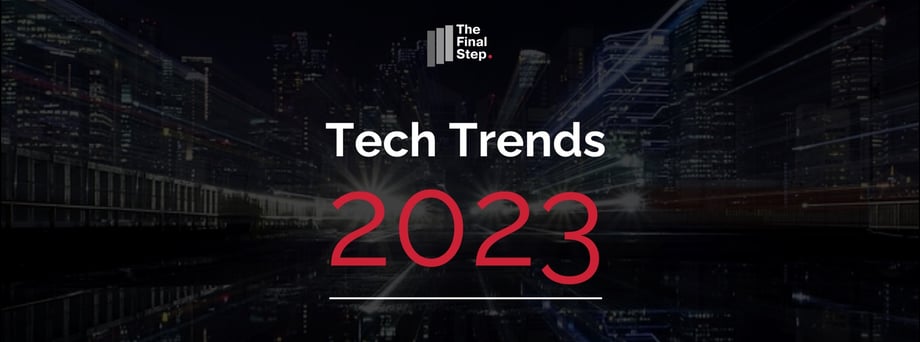Technology Trends for 2023
January is the time of year for looking back and taking stock, setting goals for the coming year and deciding what to do differently to achieve them. So, here are some highlights of what we’ve read about technology trends and themes in 2023 that are relevant for small and medium businesses (SMBs).
Artificial Intelligence
Artificial Intelligence (AI) is much talked about as a trend and opportunity to enhance productivity and competitiveness, but it’s debatable how much SMBs will invest in it. InfoTech’s survey of 813 IT professionals identifies the three most popular uses of AI:
-
Business analytics or intelligence
Turning data into information provides insights and allows for timely and accurate decision-making. Software such as Microsoft’s Power BI is still relatively little used by professional service firms but is increasingly valuable for others, those say with manufacturing and/or research elements to their work. -
The automation of repetitive, low-level tasks
Many organisations use AI such as website chatbots, basic translation services or Grammarly. More people seem willing to experiment with content creation or writing services such as Jasper AI and Anyword, finding them useful for marketing, freeing up writing blocks or making a quicker head start on research. Some feel this approach is “cheating”. Others consider it more like delegating to a colleague to get a well-researched first draft they will check. If you are wondering, this article was researched and written by a human. -
Identifying risks and improving security
An important part of cyber security is recognising and defending against known threats. Unfortunately, new threats are released constantly, existing ones change so quickly and attacks are so common this approach is insufficient on its own. Many security layers are now adding additional intelligence so that even if a risk is unidentified, it can be detected by its behaviour. We’ve updated a lot of our cyber security services over the past 18 months to mitigate the risks.
Optimise the digital
Another trend, identified by many as an imperative, is that the digitalisation forced upon us by the pandemic now has to be optimised, a development necessitated by economic uncertainty. Ideally, this optimisation of business processes allows staff to focus on higher tasks. This reduces the need to increase headcount, lowers the number of mistakes and improves client satisfaction and profitability. It’s not difficult to see why Satya Nadella has articulated Microsoft’s ability to help you do “more with less”.
Both SMBs and Enterprises are feeling the pinch. The BBC reported on tech giants making big staff cuts and recent predictions about SMBs facing collapse. Despite the economic outlook, many predict continuing investment in technology, particularly where cyber security is concerned, coupled with a need to get the most from your current investment. It’s important that IT takes into account your organisation’s priorities, aligns with your biggest opportunities and mitigates your biggest risks. In effect, technology is too important to leave to the IT department – it must be a partner and at the service of your goals.
Building Trusted Relationships
As well as optimising systems and processes, you want to maximise the value of your people in a time when much has changed in how we work. Bosses tend to value seeing people in the office and measure productivity in outcomes. Workers tend to value flexibility, remote work and measure productivity in output. There is a natural tension which means we are still figuring out where to set, and how to adjust, the dial on hybrid working. Is technology helping us collaborate, learn and focus on the behaviours that make us successful?
If you are rethinking how this works from a tech and cultural perspective, it’s worth revisiting Microsoft’s largest-ever research initiative, the New Future of Work. Hundreds of researchers at GitHub, Microsoft and LinkedIn have produced multiple research papers, practical guides and whitepapers on remote and hybrid tech. You can find these resources here: https://aka.ms/nfw. It’s also worth listening to the organisational psychologist Adam Grant’s podcast on how Microsoft is building the future of work.
Security
This year, more SMBs are likely to think of cyber security more as a business risk to be managed than as a purely technical problem. Boards will get reports and pay more attention to insurance.
Having a security first mindset takes up time and money and makes working life less convenient, but it is still required for 2023. With traditional network boundaries gone, or heavily eroded, organisations are adopting more zero trust security models. This means no device, user or access is considered “trusted”. Instead, there are multiple layers and more monitoring to check each user, device, location and permission to access data is appropriate.
The headlines will continue to be alarming and instructional, such as Yum having to close 300 restaurants for a day this January due to ransomware. Chainalysis and Coveware issued reports this month showing ransomware revenues dropped substantially in 2022 (40% by one estimate). This is due to:
- Better technical preparedness to fend off attacks.
- US government legislation has made it riskier to pay ransomware if the criminal entity is on a sanctions list.
- Insurers tightened their underwriting terms after significant losses prior to 2022 and insist on heightened security measures.
Whilst it’s good news that criminals made less money, this could be bad news for SMBs. Experts are concerned ransomware gangs will target SMBs as their return on investment declines from enterprises. The lesson to take away is that good preparation mitigates risk, so test your IT backup solutions, business continuity and recovery plans if you want to be in a position to minimise disruption or have a chance at the option not to pay a ransom. Legislation and insurers are shifting their positions, so regularly update your cyber security risk assessment and coordinate it with your insurance renewal.
We hope that 2023 is a safe, profitable, productive and rewarding year for you and your organisation.







